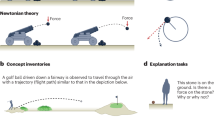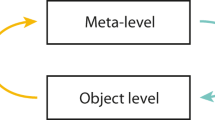Abstract
As neuroscience gains social traction and entices media attention, the notion that education has much to benefit from brain research becomes increasingly popular. However, it has been argued that the fundamental bridge toward education is cognitive psychology, not neuroscience. We discuss four specific cases in which neuroscience synergizes with other disciplines to serve education, ranging from very general physiological aspects of human learning such as nutrition, exercise and sleep, to brain architectures that shape the way we acquire language and reading, and neuroscience tools that increasingly allow the early detection of cognitive deficits, especially in preverbal infants. Neuroscience methods, tools and theoretical frameworks have broadened our understanding of the mind in a way that is highly relevant to educational practice. Although the bridge's cement is still fresh, we argue why it is prime time to march over it.
This is a preview of subscription content, access via your institution
Access options
Subscribe to this journal
Receive 12 print issues and online access
$209.00 per year
only $17.42 per issue
Buy this article
- Purchase on SpringerLink
- Instant access to full article PDF
Prices may be subject to local taxes which are calculated during checkout
Similar content being viewed by others
References
Bruer, J.T. Education and the Brain: A bridge too far. Educ. Res. 26, 4–16 (1997).
Arsalidou, M. & Taylor, M.J. Is 2+2=4? Meta-analyses of brain areas needed for numbers and calculations. Neuroimage 54, 2382–2393 (2011).
Stokes, D.E. Pasteur's Quadrant: Basic Science and Technological Innovation (Brookings Institution Press, 1997).
Korol, D.L. & Gold, P.E. Glucose, memory, and aging. Am. J. Clin. Nutr. 67, 764S–771S (1998).
Hackman, D.A., Farah, M.J. & Meaney, M.J. Socioeconomic status and the brain: mechanistic insights from human and animal research. Nat. Rev. Neurosci. 11, 651–659 (2010).
Valladolid-Acebes, I. et al. High-fat diets induce changes in hippocampal glutamate metabolism and neurotransmission. Am. J. Physiol. Endocrinol. Metab. 302, E396–E402 (2012).
Grantham-McGregor, S. Can the provision of breakfast benefit school performance? Food Nutr. Bull. 26, S144–S158 (2005).
Renfu, L. et al. Nutrition and educational performance in rural China's elementary schools: results of a randomized control trial in Shaanxi Province. Econ. Dev. Cult. Change 60, 735–772 (2012).
Erickson, K.I. et al. Exercise training increases size of hippocampus and improves memory. Proc. Natl. Acad. Sci. USA 108, 3017–3022 (2011).
Van der Borght, K. et al. Physical exercise leads to rapid adaptations in hippocampal vasculature: temporal dynamics and relationship to cell proliferation and neurogenesis. Hippocampus 19, 928–936 (2009).
Perry, B.D. Childhood experience and the expression of genetic potential: What childhood neglect tells us about nature and nurture. Brain Mind 3, 79–100 (2002).
Diekelmann, S. & Born, J. The memory function of sleep. Nat. Rev. Neurosci. 11, 114–126 (2010).
Wilhelm, I., Diekelmann, S. & Born, J. Sleep in children improves memory performance on declarative but not procedural tasks. Learn. Mem. 15, 373–377 (2008).
Stickgold, R., James, L. & Hobson, J.A. Visual discrimination learning requires sleep after training. Nat. Neurosci. 3, 1237–1238 (2000).
Wagner, U., Gais, S., Haider, H., Verleger, R. & Born, J. Sleep inspires insight. Nature 427, 352–355 (2004).
Wilhelm, I. et al. Sleep selectively enhances memory expected to be of future relevance. J. Neurosci. 31, 1563–1569 (2011).
Huber, R., Ghilardi, M.F., Massimini, M. & Tononi, G. Local sleep and learning. Nature 430, 78–81 (2004).
Kurdziel, L., Duclos, K. & Spencer, R.M.C. Sleep spindles in midday naps enhance learning in preschool children. Proc. Natl. Acad. Sci. USA 110, 17267–17272 (2013).
Marshall, L., Helgadóttir, H., Mölle, M. & Born, J. Boosting slow oscillations during sleep potentiates memory. Nature 444, 610–613 (2006).
Wilson, M. & McNaughton, B. Reactivation of hippocampal ensemble memories during sleep. Science 265, 676–679 (1994).
Ribeiro, S. et al. Induction of hippocampal long-term potentiation during waking leads to increased extrahippocampal zif-268 expression during ensuing rapid-eye-movement sleep. J. Neurosci. 22, 10914–10923 (2002).
Vecsey, C.G. et al. Sleep deprivation impairs cAMP signaling in the hippocampus. Nature 461, 1122–1125 (2009).
Hagenauer, M.H., Perryman, J.I., Lee, T.M. & Carskadon, M.a. Adolescent changes in the homeostatic and circadian regulation of sleep. Dev. Neurosci. 31, 276–284 (2009).
Hansen, M., Janssen, I., Schiff, A., Zee, P.C. & Dubocovich, M.L. The impact of school daily schedule on adolescent sleep. Pediatrics 115, 1555–1561 (2005).
Owens, J.A., Belon, K. & Moss, P. Impact of delaying school start time on adolescent sleep, mood, and behavior. Arch. Pediatr. Adolesc. Med. 164, 608–614 (2010).
Mednick, S., Nakayama, K. & Stickgold, R. Sleep-dependent learning: a nap is as good as a night. Nat. Neurosci. 6, 697–698 (2003).
Melhuish, E.C., Sylva, K. & Sammons, P. Preschool influences on mathematics achievement. Science 321, 1161–1162 (2008).
Farah, M.J. et al. Environmental stimulation, parental nurturance and cognitive development in humans. Dev. Sci. 11, 793–801 (2008).
Fisher, K., Hirsh-pasek, K., Golinkoff, R.M., Singer, D.G. & Berk, L. Playing around in school: implications for learning and educational policy in Oxford Handb. Dev. Play (Pellegrini, A.) 341–362 (Oxford University Press, 2011).
Rothbart, M.K. & Jones, L.B. Temperament, self-regulation and education. School Psych. Rev. 27, 479–491 (1998).
Korver, A.M.H. et al. Newborn hearing screening vs later hearing screening and developmental outcomes in children with permanent childhood hearing impairment. J. Am. Med. Assoc. 304, 1701–1708 (2010).
Mehl, A.L. & Thomson, V. Newborn hearing screening: the great omission. Pediatrics 101, e4 (1998).
Francis, H.W. & Niparko, J.K. Cochlear implantation update. Pediatr. Clin. North Am. 50, 341–361 (2003).
Semenov, Y.R., Martinez-Monedero, R. & Niparko, J.K. Cochlear implants: clinical and societal outcomes. Otolaryngol. Clin. North Am. 45, 959–981 (2012).
Connor, C.M., Craig, H.K., Raudenbush, S.W., Heavner, K. & Zwolan, T.A. The age at which young deaf children receive cochlear implants and their vocabulary and speech-production growth: is there an added value for early implantation? Ear Hear. 27, 628–644 (2006).
Connor, C.M. & Zwolan, T.A. Examining multiple sources of influence on the reading comprehension skills of children who use cochlear implants. J. Speech Lang. Hear. Res. 47, 509–526 (2004).
Carey, S. The Origin of Concepts (Oxford University Press, 2009).
Evers, K. & Sigman, M. Possibilities and limits of mind-reading: a neurophilosophical perspective. Conscious. Cogn. 22, 887–897 (2013).
Peña, M. et al. Sounds and silence: an optical topography study of language recognition at birth. Proc. Natl. Acad. Sci. USA 100, 11702–11705 (2003).
Dehaene-Lambertz, G. et al. Functional organization of perisylvian activation during presentation of sentences in preverbal infants. Proc. Natl. Acad. Sci. USA 103, 14240–14245 (2006).
Petersen, S.E. & Posner, M.I. The attention system of the human brain: 20 years after. Annu. Rev. Neurosci. 35, 73–89 (2012).
Davidson, M.C., Amso, D., Anderson, L.C. & Diamond, A. Development of cognitive control and executive functions from 4 to 13 years: evidence from manipulations of memory, inhibition and task switching. Neuropsychologia 44, 2037–2078 (2006).
Atance, C.M. & O'Neill, D.K. Episodic future thinking. Trends Cogn. Sci. 5, 533–539 (2001).
Medin, D., Bennis, W. & Chandler, M. Culture and the home-field disadvantage. Perspect. Psychol. Sci. 5, 708–713 (2010).
Akhtar, N. & Menjivar, J.A. Cognitive and linguistic correlates of early exposure to more than one language. Adv. Child Dev. Behav. 42, 41–78 (2012).
UNESCO. Education in a multilingual world. 〈http://unesdoc.unesco.org/images/0012/001297/129728e.pdf〉. (2003).
Bialystok, E. Bilingualism: The good, the bad, and the indifferent. Biling. Lang. Cogn. 12, 3–11 (2009).
Werker, J.F. & Byers-Heinlein, K. Bilingualism in infancy: first steps in perception and comprehension. Trends Cogn. Sci. 12, 144–151 (2008).
Kovács, A.M. & Mehler, J. Cognitive gains in 7-month-old bilingual infants. Proc. Natl. Acad. Sci. USA 106, 6556–6560 (2009).
Bialystok, E., Luk, G., Peets, K.F. & Yang, S. Receptive vocabulary differences in monolingual and bilingual children. Lang. Cogn. 13, 525–531 (2010).
Ivanova, I. & Costa, A. Does bilingualism hamper lexical access in speech production? Acta Psychol. (Amst.) 127, 277–288 (2008).
Garbin, G. et al. Bridging language and attention: brain basis of the impact of bilingualism on cognitive control. Neuroimage 53, 1272–1278 (2010).
Abutalebi, J. et al. Bilingualism tunes the anterior cingulate cortex for conflict monitoring. Cereb. Cortex 22, 2076–2086 (2012).
Posner, M.I., Rothbart, M.K., Sheese, B.E. & Tang, Y. The anterior cingulate gyrus and the mechanism of self-regulation. Cogn. Affect. Behav. Neurosci. 7, 391–395 (2007).
Bialystok, E., Craik, F.I.M. & Freedman, M. Bilingualism as a protection against the onset of symptoms of dementia. Neuropsychologia 45, 459–464 (2007).
Luk, G., Bialystok, E., Craik, F.I.M. & Grady, C.L. Lifelong bilingualism maintains white matter integrity in older adults. J. Neurosci. 31, 16808–16813 (2011).
Mischel, W. et al. “Willpower” over the life span: decomposing self-regulation. Soc. Cogn. Affect. Neurosci. 6, 252–256 (2011).
Hoff, E. Interpreting the early language trajectories of children from low-SES and language minority homes: Implications for closing achievement gaps. Dev. Psychol. 49, 4–14 (2013).
Dehaene, S. & Cohen, L. Cultural recycling of cortical maps. Neuron 56, 384–398 (2007).
Jay Gould, S. & Vrba, E. Exaptation-a missing term in the science of form. Paleobiology 8, 4–15 (1982).
Wiesel, T.N. & Hubel, D.H. Extent of recovery from the effects of visual deprivation in kittens. J. Neurophysiol. 28, 1060–1072 (1965).
Gilbert, C.D., Sigman, M. & Crist, R.E. The neural basis of perceptual learning. Neuron 31, 681–697 (2001).
Carreiras, M. et al. An anatomical signature for literacy. Nature 461, 983–986 (2009).
Dehaene, S., Cohen, L., Sigman, M. & Vinckier, F. The neural code for written words: a proposal. Trends Cogn. Sci. 9, 335–341 (2005).
Rayner, K. Eye movements in reading and information processing: 20 years of research. Psychol. Bull. 124, 372–422 (1998).
Biemiller, A. Relationships between oral reading rates for letters, words, and simple text in the development of reading achievement. Read. Res. Q. 13, 223–253 (1977).
Reicher, G.M. Perceptual recognition as a function of meaninfulness of stimulus material. J. Exp. Psychol. 81, 275–280 (1969).
Dehaene, S. Reading in the Brain: the New Science of How We Read (Penguin books, 2009).
Ullman, S. Object recognition and segmentation by a fragment-based hierarchy. Trends Cogn. Sci. 11, 58–64 (2007).
Vinckier, F. et al. Hierarchical coding of letter strings in the ventral stream: dissecting the inner organization of the visual word-form system. Neuron 55, 143–156 (2007).
Zorzi, M. et al. Extra-large letter spacing improves reading in dyslexia. Proc. Natl. Acad. Sci. USA 109, 11455–11459 (2012).
Martelli, M. & Di Filippo, G. Crowding, reading, and developmental dyslexia. J. Vis. 9, 1–18 (2009).
Goswami, U. The development of reading across languages. Ann. NY Acad. Sci. 1145, 1–12 (2008).
Temple, E. et al. Neural deficits in children with dyslexia ameliorated by behavioral remediation: evidence from functional MRI. Proc. Natl. Acad. Sci. USA 100, 2860–2865 (2003).
Gabrieli, J.D.E. Dyslexia: a new synergy between education and cognitive neuroscience. Science 325, 280–283 (2009).
Guttorm, T.K., Leppanen, P.H.T., Richardson, U. & Lyytinen, H. Event-related potentials and consonant differentiation in newborns with familial risk for dyslexia. J. Learn. Disabil. 34, 534–544 (2001).
Guttorm, T.K., Leppänen, P.H.T., Hämäläinen, J.A., Eklund, K.M. & Lyytinen, H.J. Newborn event-related potentials predict poorer pre-reading skills in children at risk for dyslexia. J. Learn. Disabil. 43, 391–401 (2010).
Leppänen, P.H. et al. Newborn brain event-related potentials revealing atypical processing of sound frequency and the subsequent association with later literacy skills in children with familial dyslexia. Cortex 46, 1362–1376 (2010).
Molfese, D.L. Predicting dyslexia at 8 years of age using neonatal brain responses. Brain Lang. 72, 238–245 (2000).
Acknowledgements
The authors thank the faculty and students of the Latin American School for Education, Cognitive and Neural Sciences (LA School) for kindling the ideas presented here, the James S. McDonnell Foundation for supporting the LA School, D. Koshiyama for librarian support, G. Gellon for reading and commenting the manuscript, and D. Klahr for inspiring the notion that educational neuroscience lies in Pasteur's Quadrant. S.R. is funded by grant 14385 (ACERTA), 049/2012/CAPES/INEP – Programa Observatório da Educação. M.S. and A.P.G. are funded by CONICET and UBACYT. M.S. is sponsored by a scholar award of the James McDonnell Foundation. M.P. is sponsored by CONICYT Chile, Fondecyt # 1110928 and IDeA CA12I10372.
Author information
Authors and Affiliations
Corresponding author
Ethics declarations
Competing interests
The authors declare no competing financial interests.
Rights and permissions
About this article
Cite this article
Sigman, M., Peña, M., Goldin, A. et al. Neuroscience and education: prime time to build the bridge. Nat Neurosci 17, 497–502 (2014). https://doi.org/10.1038/nn.3672
Received:
Accepted:
Published:
Issue Date:
DOI: https://doi.org/10.1038/nn.3672
This article is cited by
-
Odor cueing during sleep improves consolidation of a history lesson in a school setting
Scientific Reports (2022)
-
Approaching the intersection of neuroscience and education: merging perspectives to strengthen study design
SN Social Sciences (2022)
-
Post-class naps boost declarative learning in a naturalistic school setting
npj Science of Learning (2018)
-
The maturation of speech structure in psychosis is resistant to formal education
npj Schizophrenia (2018)
-
The Developing Bilingual Brain: What Parents and Teachers Should Know and Do
Early Childhood Education Journal (2018)



